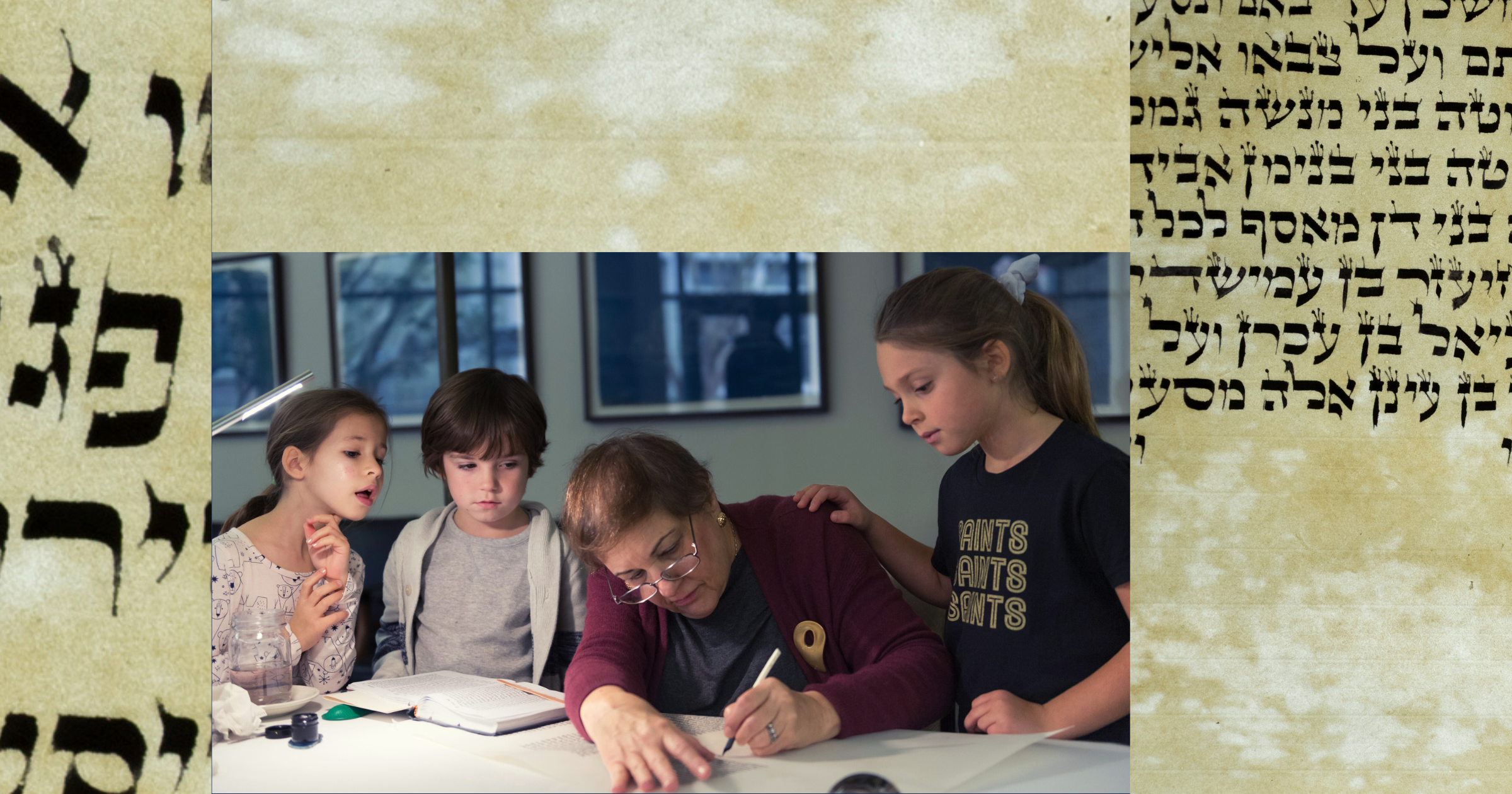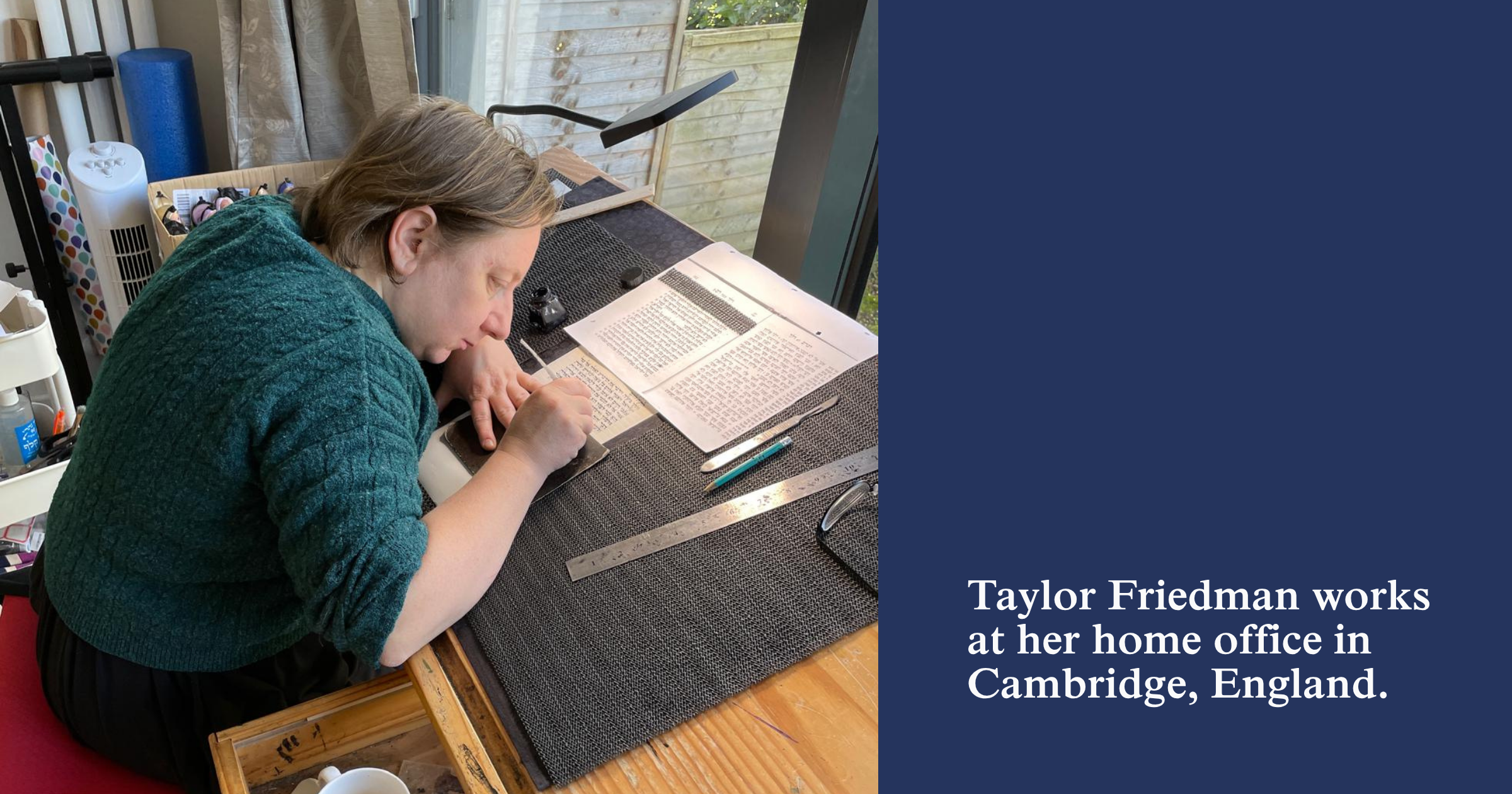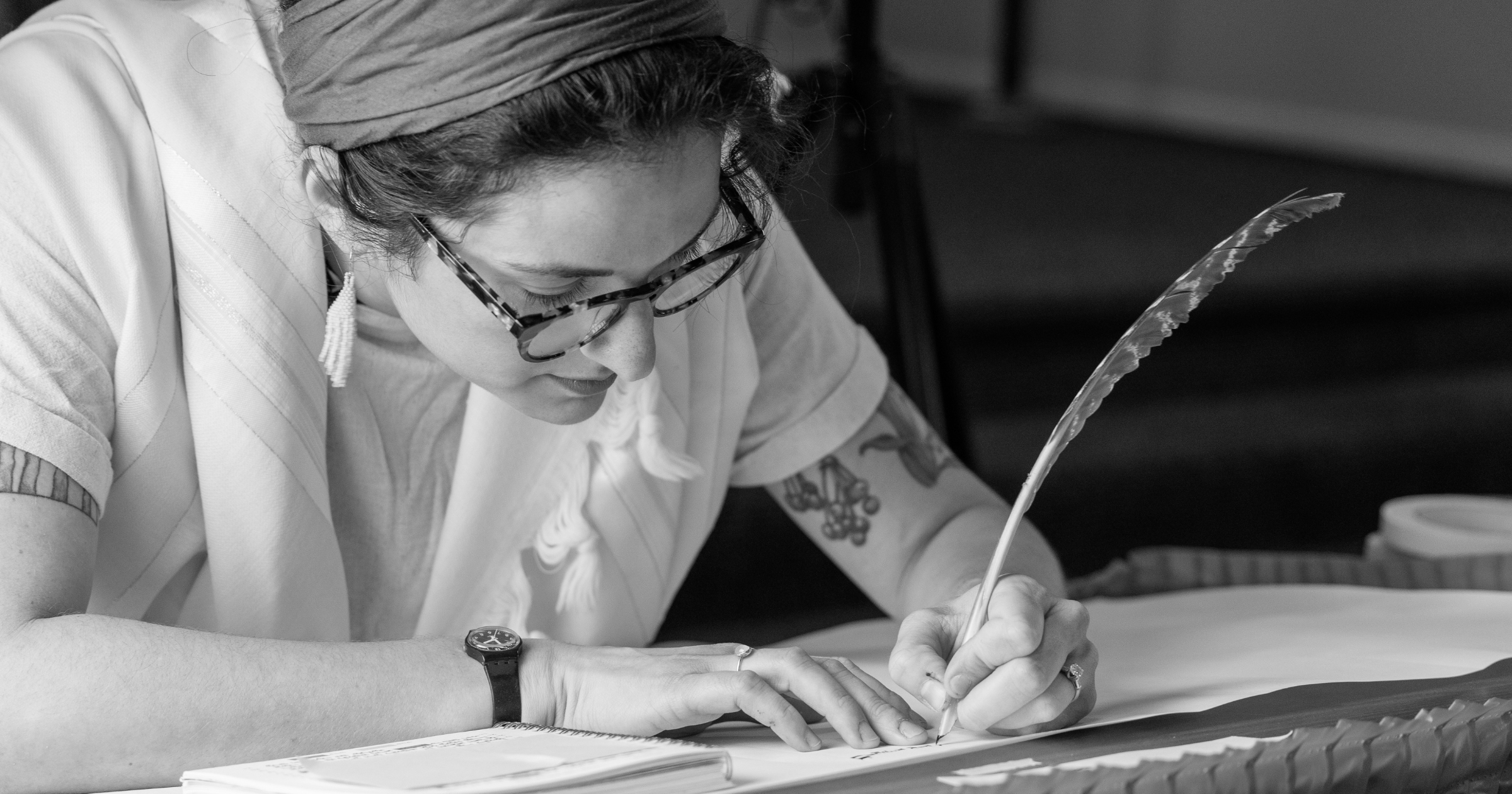Being Jewish
Feature
Women Are Rewriting the Role of Torah Scribe

Patiently and with total focus on the individual in front of her, Torah scribe Jen Taylor Friedman positioned a woman’s hand on her own. Together, they drew the Hebrew letter “hay” on the parchment in front of them, as fellow congregants looked on and sunlight shone through the soaring sanctuary windows at Beth Am Israel in Penn Valley, Pa., a Philadelphia suburb.
The woman looked up and smiled as she completed her own contribution to the Torah, which has been commissioned to celebrate the congregation’s 100th anniversary.
Taylor Friedman, the first known woman to complete an entire Torah scroll and arguably the world’s best-known soferet, the term for a female scribe, is writing this Torah over the course of a year, mostly from her home in Cambridge, England.
But in April, and again in October, she spent a long weekend in residence at the Conservative shul, illuminating the ancient Jewish art of sofrut—scribed works of scripture—for congregants who, in a growing trend for liberal Jewish communities, penned a letter of the scroll with Taylor Friedman’s guidance. In April, the oldest member, dressed in holiday finery for the occasion, was in her 90s; the youngest, just 5, skipped down the synagogue hall afterward.
From the sanctuary’s focused hush, participants walked out describing how the simple act of putting quill to Torah felt transcendent.
“The rabbi told us it’s a mitzvah to write a Torah in your lifetime, and if you write one letter, it’s as if you wrote the whole Torah,” Cindy Rozenberg, a Beth Am Israel congregant, said following her own turn with Taylor Friedman. “So everyone is getting to fulfill that mitzvah of writing a whole Torah by participating.”
“The best are the ones who are like, ‘Oh, I’m just coming along here because my mum dragged me along. She’s 80, and I’m 40, and I’m too old for this crap,’ ” chuckled Taylor Friedman weeks later, back home in England. “And then they do it, and they’re like, ‘Whoa….’ ”
The feelings that come with writing a Torah have special resonance for Jewish women, who were historically excluded from this most solemn undertaking. Since Taylor Friedman penned her first Torah in 2007, several dozen women have followed suit, scribing numerous scrolls and creating an entire professional category that did not exist a generation ago. Their exact number is elusive due to the fluidity of the small community. Most train informally, without earning specific diplomas, and sofrot, the plural of soferet, typically balance Torah projects with roles as artists, rabbis and teachers.
They join the women almost exclusively from Judaism’s liberal denominations who, over the past 50-plus years, have broken ground as rabbis, mohels and other clerical positions that, for millennia, were held entirely by men.
“In the broader context of social change, we’ve got women [synagogue] presidents, we’ve got egalitarian congregations, we’ve got women counting in the minyan,” reflected Taylor Friedman, who is in her 40s. “From that perspective, it was only a matter of time before you had women doing all the things.”

Sofrot have not only broadened Jewish tradition, they have also created a community, at once global and local, of Jewish women ranging from teen apprentices to retirees drawn into sacred collaboration. The scribes include Linda Coppleson, a New Jersey Jewish educator, calligrapher and sometime Taylor Friedman collaborator; and Bec Richman, a Cleveland-based rabbi and artist mentored by Taylor Friedman who is now scribing her first scroll.
There is also Rachel Reichhardt of Brazil, the first woman in Latin America to receive a scribal diploma, from the Latin American Rabbinic Seminary in Buenos Aires; Linda Motzkin, a retired rabbi living in Eugene, Ore., who has led myriad congregations in scroll production through her Community Torah Project; and Shoshana Gugenheim Kedem, a Portland, Oregon-based American Israeli scribe and artist and the founder of numerous Jewish feminist art projects.
Virtually all are members of the international collective Stam Scribes. STaM is the traditional abbreviation appended to the title of sofer and stands for “sefer Torah, tefillin and mezuzah,” the three principal scribal products.
On a WhatsApp group, at informal in-person gatherings and as long-distance collaborators, the women of Stam Scribes mentor and learn from each other, stepping in to lend a hand, literally, on complex endeavors.
Among the best-known of these endeavors was the Women’s Torah Project (WTP), a landmark enterprise that, between 2003 and 2010, produced the first-ever Torah to be entirely scribed and embellished with ornamentation by women, created for the Kadima Reconstructionist Community of Seattle.
“There were a number of women who sort of became interested in it and started to find their own path to it around the same time,” recalled Coppleson. She was one of the WTP scribes and, now in her 70s, is among the sofrut movement’s senior members.
“I don’t think that I went into it to be a flag-bearer for feminism,” she added, though she was primed for such a role, having grown up in the Young Judaea movement and having celebrated her bat mitzvah some 60 years ago, when the rite was less common, particularly at a Conservative synagogue. She noted that women today “enrich the tradition, because they approach it in a different way.”

Coppleson was a longtime educator at the Golda Och Academy (formerly the Solomon Schechter School), a West Orange, N.J., Conservative-affiliated institution where she taught Jewish history, rabbinics and, as her interest in Jewish calligraphy deepened, Jewish scribal arts. Seeking to go deeper, she began a formal study of sofrut in 2003 with Rabbi Eric Ray, a legendary British sofer who dreamed of opening an egalitarian scribal academy.
“His reputation was such that it was said that he could tell where and by whom a Torah was written within 50 miles of its creation,” she recalled.
From Ray, she learned the mechanics—“the formation of letters, cutting the quill, the rules about writing and spacing,” she said. After he died in 2004, Coppleson formed a study partnership with Taylor Friedman, reviewing the meticulous halachic tenets of sofrut weekly for several years.
“There are myriad rules of writing: how to make corrections—and there are so many corrections—the rules about erasing and about re-scribing the lines,” Coppleson explained. “It’s all very detailed.” Scribes must utter blessings before writing any of the names of God. And any mistake, one as small as a miswritten letter, could render an entire scroll unkosher.
There are also rules about scribes themselves: Women (along with heretics, gentiles, those with disabilities and anyone under the age of 13) are barred from writing a Torah scroll under traditional halacha, and there are no female Orthodox scribes. While halacha does not require a mikveh visit before scribing, many scribes, including men, dip ceremonially before sitting at what are typically angled, well-lit desks to write with the required ink and quills or reeds. On most scribes’ desks sit blades for sharpening quills and materials for correcting mistakes on the parchment used for the scrolls, such as erasers and sandpaper.

Taylor Friedman grew up in Southampton, England, and credits her pioneering role in sofrut to her intellectual training as a math student at Oxford. “ ‘This, and therefore, logically, this other thing’—that’s the structure of analysis I am familiar with,” she noted. “Talmud is a lot like math, but with exciting twists and turns because people are human.” The tangible nature of sofrut attracted Taylor Friedman “because it connects you into something that’s much, much larger.
“The rabbis of the Talmud said even writing just one letter,” she continued, is something that everyone should do “because it’s not the same as just reading it or listening to it or talking about it. You are creating a thing, and it’s something that we have been doing for two and a half thousand years, which is pretty amazing.” (Though the Talmudic rabbis were of course referring only to men.)
After studying at a yeshiva in Israel, Taylor Friedman moved to New York City with her first husband, where she became known for her scribing of megillot. It was prominent sofer Neil Yerman who recruited Taylor Friedman to write her first Torah in 2007, a commission for United Hebrew Congregation, a St. Louis Reform synagogue.
Settled back in the United Kingdom with her second husband, Taylor Friedman, a busy mom of one, is now working on multiple scrolls concurrently. Each will take about a year, a timeline that is typical for full-time scribes. Like most others in the field, Taylor Friedman, a member of Cambridge’s Beth Shalom Reform Synagogue, also consults on scribal projects and teaches the craft online to both male and female aspiring scribes. (Apprenticeship is the primary way most men and women train.)

Despite the designation, she’s pretty certain that she wasn’t the first woman to complete a Torah. “I’m just the first one whose name we know,” said Taylor Friedman, who added that one of her current projects probably is a first—a megillah scribed on giraffe parchment.
Taylor Friedman was part of the WTP for the Kadima congregation in Seattle—a galvanizing event for the fledgling soferet community. Nearly two decades later, those involved still marvel at the sense of mission that bonded the global feminist enterprise.
In the end, six sofrot contributed to the WTP from their far-flung studios, including Coppleson, Gugenheim Kedem and Reichhardt; Taylor Friedman helped check the work. Seven Judaica artists from across the United States, Israel and Latin America contributed elements, including a yad, the pointer used to guide the Torah reader; a decorative clasp; and a pomegranate-themed patchwork Torah covering to which congregants contributed scraps of fabric.
“All these individual pieces came together to become something so much greater than a Torah,” said Wendy Graff, a longtime Kadima congregant who coordinated the project. “It became this opportunity for women and men to work together to change the world.”

That change is already evident in the popularity within liberal synagogues of participatory, congregation-commissioned Torahs and in the number—still modest but no longer novel—of those Torahs penned by women. Rabba Sara Hurwitz, the first woman to be ordained by an Orthodox seminary, suggests that it could be only a matter of time before an Orthodox soferet emerges.
“Being able to learn from and follow the trajectory of women in the other denominations has been very useful and helpful,” said Hurwitz, the co-founder and president of Yeshivat Maharat, a Modern Orthodox seminary for women. “The writing of a Torah scroll is a holy endeavor, and there are Jewish law requirements at every step of the way, from acquiring the parchment to how it’s sewn together and how to ink the letters. The fact that women didn’t have access to this knowledge for so long, and now they do—it’s inevitable that they would want to take that knowledge and put it to use.”
And when they do, sofrot say they approach the process of writing a scroll a bit differently than their male counterparts.
“When you open up things to women, the communal nature of it shifts,” reflected Linda Motzkin, who, in her 60s, is part of that first generation of female scribes.

Rabbi Bec Eichman, in her 30s, is among the youngest generation of scribes. She is now working on her first Torah, for Beth El-The Heights Synagogue in Cleveland, where she is a member. She’s also writing a book about sofrut and teaching others in short-term scribal residencies.
Interested in art since her early childhood, Richman found her niche while studying to become a rabbi at the Reconstructionist Rabbinical College near Philadelphia. Delving into the tradition behind each Hebrew letter “became a central part not only of my rabbinic learning, but also of my understanding of Judaism as a whole,” Richman said. “We’re a people of the book, but also a people of the hand. We are so tactile in the ancient practices that we have engaged in ritually throughout time.”
Richman noted that a few years ago, Linda Coppleson, the New Jersey Jewish educator and artist, became the first woman to have a grandchild read from a Torah she had personally scribed. In a decade or so, Richman expects her own children to do so for their b’nei mitzvah. “That, for me, is a huge and important element of ancestry and inheritance and relationship to the matrilineal line in Judaism,” she said.
“All of us know that we’re not welcome in the traditional men’s scribing spaces,” Richman said. “And so, over the years, we’ve made our own sacred circle, with this unabashed determination: Torah is as much ours as it is for anyone else.”
Hilary Danailova writes about travel, culture, politics and lifestyle for numerous publications.










 Facebook
Facebook Instagram
Instagram Twitter
Twitter
Leave a Reply